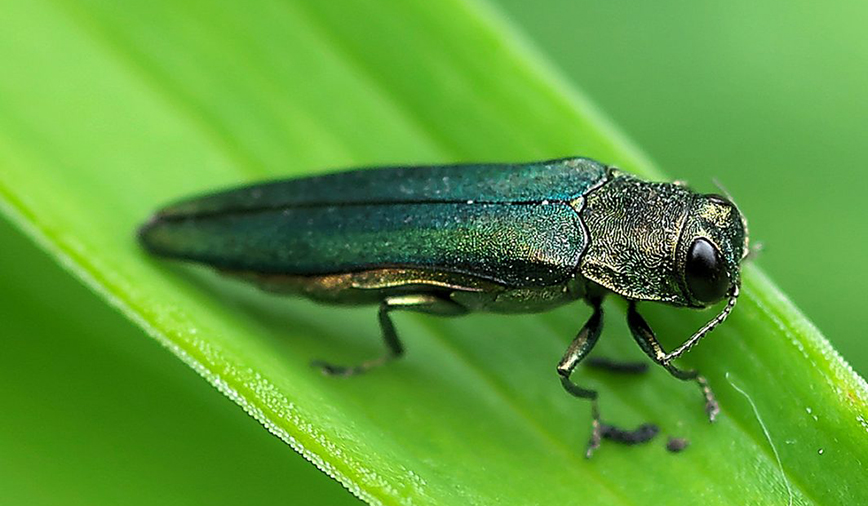Pam’s Perspective
Pam Otto is the Manager of Nature Programs and Interpretive Services for the St. Charles Park District
When a headliner comes to town, people usually flock from miles around hoping for a chance to see to see him or her. Add the term “limited-time only” and the crowds can get downright fanatical. But when the celebrity is an insect, and it is loathed rather than loved, the response is much less enthusiastic.
I may be wrong, but I think the other day I was the only one strolling the streets of southwestern St. Charles, scanning high and low for a look at our most infamous new invader, the emerald ash borer. The really sad thing was, I didn’t have to look very long.
I was walking home from Jewel, the one on the west side of town, and noticed some small ash trees in pretty sorry shape. The crowns had died back, the bark was ravaged, and they all sported suckers—small and basically ineffectual sprouts of twigs and leaves on their trunks. In fact one tree, making a last stab at survival, had produced suckers with leaves the size of dessert plates, a sure sign that its end is near.
While it was those abnormally large leaves that caught my eye, it was the tiny creatures sunning themselves there that got my heart pounding. Stretched out on the leaves and bark were five emerald ash borer beetles. Their stunning green bodies shone in the afternoon sun and, as their giant eyes stared back at me, I couldn’t help but think how much they look like aliens—the sort you’d expect to see in Roswell, NM, not St. Charles, IL.
Agrilus planipennis, as they’re known to scientists, or EABs, as the rest of us refer to them, are small—maybe a half-inch in length. But the damage they’ve caused in the nine years since they first were spotted on U.S. soil is enormous. Native to Asia, EABs first were spotted in southeastern Michigan in 2002. The thinking is that they arrived as stowaways, probably within wood used as packing material. Since that time they have spread to at least 14 states, including Illinois, and have killed millions upon millions of ash trees.
Kane County made national news in 2006 when the beetles turned up in a tree in Campton Township, a considerable distance from where they previously had been seen. Today there’s not an ash tree around that’s not vulnerable to infestation.
Driving around the TriCities, it’s not hard to spot ash trees—even if you’re unfamiliar with the species’ characteristics of compound leaves and gray, diamond-patterned bark. These days, you can just look for trees that aren’t doing well. Chances are good what you spot will be an ash.
But what can be more difficult to find are the culprits of this widespread destruction: the ash borers themselves. Besides being tiny, these guys are rarely visible. Except for right now.
Today you can walk up to virtually any ash tree that’s showing signs of infestation, and you’ll see mom and pop EAB hanging out on the trunks and leaves. They’ve recently emerged, having spent their larval days below the bark’s surface eating the tree’s living tissues and cutting off its flow of water and nutrients. Now they’re out and about, feeding on ash leaves (an action that causes only small amounts of cosmetic damage to their host trees) and mating (the deed that will trigger another round of ash devastation).
Is there anything that can be done to stop their spread? Well, right now there are some chemical treatments available, provided the tree isn’t too far gone. And, some suburbs are experimenting with biological control, introducing teensy parasitic wasps that attack EABs at various life stages.
(Continued on Page 2)
Pam’s Perspective – Page 2
But the biggest thing the average person can do is to help slow down the dispersal. If you purchase firewood, make sure it’s from a reputable, local source. If you’re transporting firewood—well, don’t. Kane County, in fact the entire state of Illinois, is under an emerald ash borer quarantine, so the movement of firewood and in fact any ash material (nursery stock, wood chips, you name it) is illegal.
I suppose there is one other thing you can do. It’s easy, and kinda fun: The next time you see an EAB, pause for a minute to admire its celebrated emerald beauty. Then, without another second’s hesitation, haul off and squish it. It’s easy, and kinda fun. Even better, the ash you save just might be your own.
Pam Otto has emerald ash borer goo on her shoes this week, and is the manager of nature programs and interpretive services for the St. Charles Park District. She can be reached at potto@stcparks.org or 630-513-4346.

